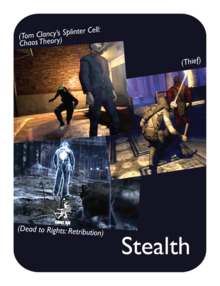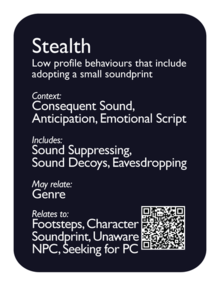Difference between revisions of "Stealth"
ValterAlves (Talk | contribs) m |
ValterAlves (Talk | contribs) m |
||
| Line 18: | Line 18: | ||
| revisions =Introduced in version 1.0 | | revisions =Introduced in version 1.0 | ||
| description = | | description = | ||
| − | Sound plays a special role in [[Stealth]] actions: the sound associated to the PC's actions | + | Sound plays a special role in [[Stealth]] actions: the sound associated to the PC's actions is relevant for the [[Gameplay]] (that means [[Consequent Sound]]), namely in terms of the reaction of the NPC. Games of the [[Stealth|Stealth ]] [[Genre]] (or sub-genre) make an extensive of such explorations. |
| − | Being able to perform [[Stealth]] actions implies that it is possible to adopt a low profile behaviour in order to avoid unwanted attention. That calls for a proper design of the [[Character Soundprint|Character's Soundprint]], which, for instance, depends on the magnitude of the movements. [[Footsteps]], in particular, are usually explored with | + | Being able to perform [[Stealth]] actions implies that it is possible to adopt a low profile behaviour in order to avoid unwanted attention. That calls for a proper design of the [[Character Soundprint|Character's Soundprint]], which, for instance, depends on the magnitude of the movements. [[Footsteps]], in particular, are usually explored with that purpose. |
| − | Using modifiers to conceal the sound of PC's actions ([[Sound Suppressing]]) may also be integrated as part of the [[Gameplay]]. | + | Using modifiers to conceal the sound of the PC's actions ([[Sound Suppressing]]) may also be integrated as part of the [[Gameplay]]. |
Conversely, sound can also be used as tool to overcome opponents. Two examples are the use of [[Sound Decoys]] and [[Eavesdropping]]. | Conversely, sound can also be used as tool to overcome opponents. Two examples are the use of [[Sound Decoys]] and [[Eavesdropping]]. | ||
| − | Ways to provide feedback to the player regarding the interest and state of awareness of NPC towards the PC | + | Ways to provide feedback to the player regarding the interest and state of awareness of the NPC towards the PC include designing explorations such as [[Unaware NPC]], [[Suspicious NPC]] and [[Seeking for PC]]. |
| − | The nature of [[Stealth]] actions propitiates design opportunities in terms of the [[Emotional Script]], | + | The nature of [[Stealth]] actions propitiates design opportunities in terms of the [[Emotional Script]], such as the exploration of [[Anticipation]]. |
| examples= | | examples= | ||
Revision as of 01:29, 17 October 2011

|

| |
| The card's front face | The card's back face |
Contents
Synopsis
| Low profile behaviours that include adopting a small soundprint. |
Relationships
Context:
Consequent Sound ![]() , Anticipation
, Anticipation ![]() , Emotional Script
, Emotional Script ![]() .
.
Includes:
Sound Suppressing ![]() , Sound Decoys
, Sound Decoys ![]() , Eavesdropping
, Eavesdropping ![]() .
.
May relate:
Genre File:M385px-Genre-front-v20.png.
Relates to:
Footsteps ![]() , Character Soundprint
, Character Soundprint ![]() , Unaware NPC
, Unaware NPC ![]() , Seeking for PC
, Seeking for PC ![]() .
.
Description
Sound plays a special role in Stealth actions: the sound associated to the PC's actions is relevant for the Gameplay (that means Consequent Sound), namely in terms of the reaction of the NPC. Games of the Stealth Genre (or sub-genre) make an extensive of such explorations.
Being able to perform Stealth actions implies that it is possible to adopt a low profile behaviour in order to avoid unwanted attention. That calls for a proper design of the Character's Soundprint, which, for instance, depends on the magnitude of the movements. Footsteps, in particular, are usually explored with that purpose.
Using modifiers to conceal the sound of the PC's actions (Sound Suppressing) may also be integrated as part of the Gameplay.
Conversely, sound can also be used as tool to overcome opponents. Two examples are the use of Sound Decoys and Eavesdropping.
Ways to provide feedback to the player regarding the interest and state of awareness of the NPC towards the PC include designing explorations such as Unaware NPC, Suspicious NPC and Seeking for PC.
The nature of Stealth actions propitiates design opportunities in terms of the Emotional Script, such as the exploration of Anticipation.
Examples






